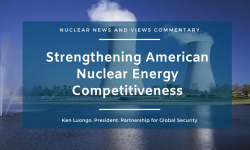The results of the U.S. election have not been certified but there is a strong likelihood of a new administration in January. If so, it will need to move quickly to reestablish effectiveness on the climate agenda. An important way to demonstrate leadership is to act on an integrated strategy to advance next-generation nuclear energy as a key element in a full suite of zero-carbon technologies.
As a respected bipartisan expert noted at the recent Global Nexus Initiative (GNI) webinar on decarbonization, nuclear power is now in the clean energy family. That wasn’t always the case and it is still controversial in some quarters. But maintaining its importance on the carbon-free energy agenda will require an extension beyond the aging fleet of existing reactors, many of which face a retirement cliff at mid-century.
Returning the U.S. to the Paris Climate Agreement, which it officially left this week, is a priority because it will realign the country with other nations and offer a renewed leadership opportunity. But this step is insufficient without assertive action. At the moment the Paris agreement targets are not being met with much besides rhetoric.
Shifting the U.S. government into a high gear won’t be easy. The country’s reputation for policy leadership, consistency, and results has been seriously damaged both at home and abroad. And governmental alacrity has been increasingly diminished by a combination of structural sclerosis, bureaucratic caution, and political inconsistency.
But next-gen nuclear is one of the rare areas of bipartisan agreement and that makes it uniquely positioned to be aggressively moved forward by the U.S. in collaboration with its allies.
However, the next-gen nuclear focus cannot continue to be technology centric and policy poor, as is currently the case. A strong policy ecosystem is necessary to support the reactor technologies and their global deployment.
There are at least five interlocking components to an effective and integrated next-gen nuclear policy framework.
The rationalization of the international regulatory system for these reactors is a top priority. It will be a significant impediment to success if individual nations write different regulations that require reactor vendors to customize their product to widely disparate requirements. A universal regulatory regime is probably too much to ask for, but a harmonized system among the major developer and exporting nations is possible. Canada and the U.S. have already moved in this direction and they are engaging with other nations and international organizations. This harmonization is not a luxury, it is an essential underpinning for the future viability of these technologies, in part because it would open the door to serial manufacturing capability which could reduce costs and result in standardization.
Equal in importance to regulation is the need for strong nuclear safeguards and security for the next generation of nuclear technologies. A number of these reactors have unique characteristics and fuel cycles. New analyses are grappling with these issues, including GNI’s, and governments are engaging with reactor designers and international organizations including the International Atomic Energy Agency (IAEA). But there are many designs, many aspects of the technology that are not inside the current international governance envelope, and much more work to be done in this area. Without effective safeguards and security structures these reactors, at least those developed by democratic nations, will stall.
Identifying the market and non-electricity uses for these reactors also is essential. The international market is attractive because developing economy nations are potentially well suited for the deployment of these technologies. But many of these nations are nuclear newcomers and face a steep learning and governance curve in preparing for them. There will need to be a more focused assessment to characterize the target markets and the support systems required to allow for safe and secure operation of reactors in these nations. Similarly, if these new technologies are being seriously contemplated for industrial uses (remote energy production, process heat, hydrogen production) then numerous questions must be answered. The oversight and preparation responsibilities will extend beyond the IAEA and its nuclear Milestones matrix. It likely will require the active involvement of the exporting nation and the vendor. That is a major change from past practice and the groundwork for this evolution is not well developed.
The export potential of next-gen technologies raises the stakes of nuclear geopolitics. Russia has come to dominate the international market for large reactors. China is looking to make inroads in the large reactor export area and is locking up energy and infrastructure in the developing economy world under the Belt and Road Initiative (BRI). Both nations are at work on small, exotically fueled future reactors. There is a very real potential for these two authoritarian governments to lockdown the 21st century’s global nuclear market. That has serious security consequences, and it would be a major challenge to the global influence of the U.S. and its allies. Nuclear geopolitics is a now mostly a talking point, although the recent action of the U.S. International Development Finance Corporation now allows it to provide overseas nuclear finance. But there is no cohesive strategy for addressing the geopolitics of nuclear power at the moment.
In order to unleash the potential of next-gen technologies, the public has to buy-in psychologically and emotionally. Achieving that social license is a major challenge for any type of nuclear energy. It is not enough to tout the technology. The ability to effectively communicate value and how the technology fits within the larger global narrative about responding to climate change and ensuring safety, security and non-proliferation is essential. So far, there are primarily talking points on these issues, not deep engagement. Canada has done significant and effective work on stakeholder engagement. The U.S. has not done enough.
It looks like change may be coming to Washington, but with it comes a significant responsibility to effectively respond to the climate challenge. The country has had fits, starts, and failures in its past efforts to move toward zero-carbon. But the stakes are much higher now. Next-gen nuclear is a key component in a comprehensive technology strategy. But it requires a lot more support and attention than other technologies in the clean energy family. An essential part of that activity is developing an integrated policy framework and aggressively following through on the actions required to move it in parallel with technology advances. A complete policy ecosystem is necessary to support the technology. We can’t afford to fail for lack of one.
Ken Luongo, President, Partnership for Global Security




